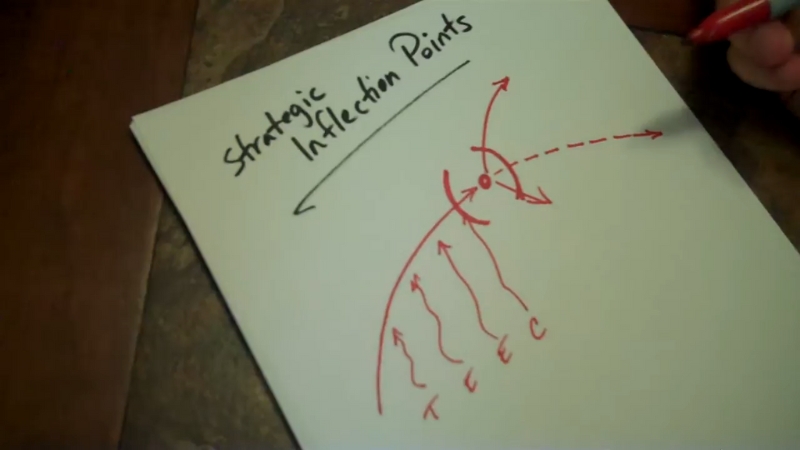A strategic inflection point (SIP) is the moment when fundamental changes in an industry, market, or technology force a company to adapt, or risk decline. The term was popularized by Andy Grove, the legendary CEO of Intel, who described it as the time when a business must make critical choices to survive disruptive shifts.
According to McKinsey & Company (2024), companies that successfully navigate these inflection points are 3× more likely to outperform their industry peers over the next decade, while those that fail to adapt often shrink or disappear.
Your business either evolves to capture new opportunities or continues on its current path and becomes irrelevant. Think of Kodak ignoring digital cameras, or Netflix pivoting from DVD rentals to streaming.
The difference between failure and long-term success often lies in how leadership recognizes and responds to these moments.
What Exactly Is a Strategic Inflection Point?
A strategic inflection point occurs when the assumptions that supported your current business model el no longer true. This could come from new competitors, shifts in customer behavior, technological innovation, regulatory changes, or global economic forces.
At its core, it is not just “change”; it is nonlinear change, meaning the old playbook no longer works, and incremental adjustments are not enough. Instead, bold strategic decisions are required.
Characteristic
What It Means
Example
Nonlinear shift
Gradual improvement won’t work anymore; it requires a new direction
Print newspapers are declining despite digital ads increasing
Disruption in assumptions
What worked in the past stops working
The taxi industry is assuming physical hailing would remain standard
Urgency of action
Delay in response increases the risk of failure
Nokia is losing smartphone dominance to Apple and Android
Potential upside
Companies that pivot early can capture huge market share
Netflix is moving early into streaming
Why It Matters: The Stakes of Recognizing SIPs
Strategic inflection points are make-or-break moments because they separate companies that stay relevant from those that fade away.
Research by Harvard Business Review (2023) found that in the decade following a major disruption, up to 40% of market leaders lose their position if they fail to respond decisively.
For leaders, the challenge is twofold:
- Recognizing the inflection point in time. Often, it does not look like a crisis at first; it may appear as small shifts in customer preferences or a new competitor on the edges.
- Making bold but calculated moves. Incremental tweaks usually are not enough. Successful companies invest in new capabilities, divest from outdated ones, and sometimes even reinvent themselves entirely.
Triggers of Strategic Inflection Points

1. Technological Disruption
New technology often makes old models obsolete. Artificial intelligence, blockchain, and cloud computing are current examples.
2. Market or Customer Shifts
Consumer expectations evolve rapidly. Companies that fail to meet these new demands fall behind.
3. Competitive Dynamics
New entrants can reshape industries by offering cheaper, faster, or more convenient alternatives.
4. Regulatory and Policy Changes
Laws or trade rules can quickly alter industry dynamics.
5. Global Economic Forces
Recessions, supply chain disruptions, or geopolitical events can accelerate or create inflection points.
How to Recognize a Strategic Inflection Point
Signal
What It Looks Like in Practice
Declining customer loyalty
Longtime clients exploring alternatives despite brand strength
Falling profit margins
Costs rising faster than revenue, even with sales growth
Competitors are growing unexpectedly fast
Startups are taking market share quickly with innovative offerings
Tech adoption outpacing your company
Customers prefer digital-first solutions that you don’t yet provide
External pressure from regulation
New laws force changes in operations, compliance, or pricing
Recognizing these signs early gives leaders the breathing room to act before the disruption becomes irreversible.
Strategies to Navigate an Inflection Point
View this post on Instagram
1. Reevaluate Core Assumptions
Ask: “What are we assuming about customers, competitors, and technology that might no longer be true?” Many companies fail because they cling to outdated truths.
2. Invest in Innovation
R&D, partnerships, and acquisitions can help a company reposition itself. Intel, for example, pivoted from memory chips to microprocessors after Andy Grove identified their inflection point.
3. Diversify Offerings
Expanding into adjacent products or services can spread risk. For example, Apple moved from computers to music devices, then to smartphones, then to services.
4. Leverage Data and Analytics
Data can reveal shifting customer patterns before they are obvious. Predictive analytics, AI, and machine learning now help companies spot inflection points earlier.
5. Empower Leadership and Culture
Bold pivots require leaders who can make tough calls and teams willing to adapt. A culture of agility, where employees embrace change, greatly increases success.
Real-World Examples

Netflix: Mastering the Pivot
Netflix is one of the clearest examples of recognizing and acting on a strategic inflection point. Initially, it was a DVD-by-mail service. As internet speeds improved and consumer habits shifted, leadership recognized the risk of clinging to physical rentals.
Netflix invested early in streaming technology, then later in original content production. These bold moves transformed it from a niche DVD rental company into a global entertainment powerhouse with over 250 million subscribers by 2025.
Kodak: Missing the Moment
Kodak invented the digital camera in 1975 but failed to embrace it, fearing it would cannibalize its film business. By the time digital photography became mainstream, Kodak had lost its dominance to rivals like Canon, Sony, and Nikon.
Kodak declared bankruptcy in 2012, a stark reminder of what happens when leaders ignore their strategic inflection point.
Microsoft: Reinvention Through Cloud
Microsoft faced stagnation in the early 2010s as its dominance in personal computers waned. Recognizing the shift toward cloud computing, Satya Nadella reoriented the company around Azure and subscription services like Office 365.
This bold pivot transformed Microsoft into a leader in the cloud era, propelling it back into the top tier of global companies.
Conclusion
@courtneylsandersHow I Hit the Inflection Point in My Business? It’s like when you think about water boiling. Something like that. You have to wait until it gets to a boiling temperature or else it will not boil. #coaching #coachingprogram #courtneylsanders♬ original sound – Courtney Sanders
A strategic inflection point is not just a threat; it is an opportunity. Companies that can recognize the signs, act boldly, and realign their strategy emerge stronger and often redefine their industries. Those who hesitate risk fading into irrelevance.
According to Accenture’s 2024 Global Disruption Index, 70% of executives say their industries are facing more frequent inflection points than ever before, driven by rapid technological change and shifting global dynamics.

